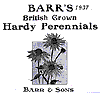accepted name (2007):
P. officinalis ssp. microcarpa (Boiss. & Reuter) Nyman
Aiton, 1811, Paeonia humilis. Dwarf Peony Bot Mag. Paeonia t. 1422


1890
Lynch
Sub-genus Paeon.
Herbaceous. Petals not leathery, large and expanding, much exceeding the sepals.
E. Leaves glaucous, or of very pale green above, generally of striking grey-green aspect; leaflets glaucous below, and very rarely without distinct pubescence, always divided, and with the lobes often fissured. (See figs. 30-33.)
I. Flowers distinctly stalked, not apparently sessile, and resting on the upper leaves.
* Carpels glabrous.
15. P. humilis, Retz., Bot. Mag., t. 1422.— Stems 11/2 to 2 feet high. Leaves biternate, petioles tinged with red, the terminal free, stalked, divisions of three lobes, the middle one trifid. Corolla rose-red. Stigmas long and upright, hooked at the top. South of France.
1923
Ascherson & Graebner Synopsis der mitteleuropäischen Flora 5, II, 546-558.Leipzig 1923
II. Fruchtblätter wenigstens zur Fruchtzeit verkahlend.
a. humilis. Blätter gross, die oberen doppelt 3theilig. Lappen der Blätter länglich bis länglich-oval, stumpf bis stumpflich, ziemlich kurz, unterseits zottig. Fruchtblätter dünn behaart bis verkahlend.
In Süd-Frankreich angegeben, die Angabe aber nach Rouy u. Foucaud (Fl. France I. 146) sicher irrthümlich durch Verwechselung mit anderen Formen, die Abart 2 im Departement Gard die Grenzen des Gebietes erreichend.
P. humilis Retz. Obs. III. 35 (1783). Koch Syn. ed. 2. 28. — P. peregrina var. humilis Koch in Flora XXIV. 2. 441 (1841). Huth in Engl. Jahrb. XIV. 270 (1891). — P. peregrina var. leiocarpa Coss. Not. pl. crit. II. 93 (1851). — P. microcarpa Boiss. u. Reut. Pugill. pl. nov. 3 (1852). Nym. Consp. 22 Suppl. 14. — P. peregrina Form. P. microcarpa Rouy u. Fouc. Fl. France 1.146 (1893). — P. feminea c. humilis Gürke in Richter-Gürke Pl. Eur. II. 402 (1903).
Ist nach Huth (a. a. 0.) vielleicht nicht von villosa zu trennen. —
Hierzu gehört:
2. leiocarpa.[Von gr. leios, glatt und gr. karpos, Frucht.] In allen Theilen kleiner. Blätter ziemlich klein, die oberen dreitheilig; die Lappen kurz, klein, stumpf bis spitzlich, unterseits behaart. Fruchtblätter kahl. — Westliches Süd-Frankreich. — P. paradoxa [beta] leiocarpa DC. Prodr. I, 66(1824) im engeren Sinne. — P. peregrina Forme P. leiocarpa Rouy u. Foucaud Fl. France I. 145 (1893). — Hierzu [beta] microphylla (Rouy a. Foucaud a. a. 0. |1898|). Blätter sehr klein.
(Verbreitung der Rasse humilis: Mediterranes Südwest-Frankreich; Spanien; Portugal.)
listed by:
1946
1964
Cullen & Heywood
P. officinalis L. subsp. humilis (retz.) cullen & heywood, comb. et stat. nov.
Syn. P. humilis retz., Obs. Bot. 3: 35 (1783), rothmaler, Feddes Repert. 49: 176 (1940); F. C. Stern, A study of the genus Paeonia 104 (1946).
Distribution: Portugal, Spain, France.
1995
Cullen & Heywood in Tutin: Flora Europaea
(d) Subsp. microcarpa (Boiss. & Reuter) Nyman, Consp. 22 (1878) (P. microcarpa Boiss. & Reuter, P. humilis Retz., P. officinalis subsp. humilis (Retz.) Cullen & Heywood, P. paradoxa G. Anderson): Stems and petioles pubescent. Leaflets divided to not more than 1/3 of the distance to base. Follicles glabrous. S, W. Europe.
(photos)




^




